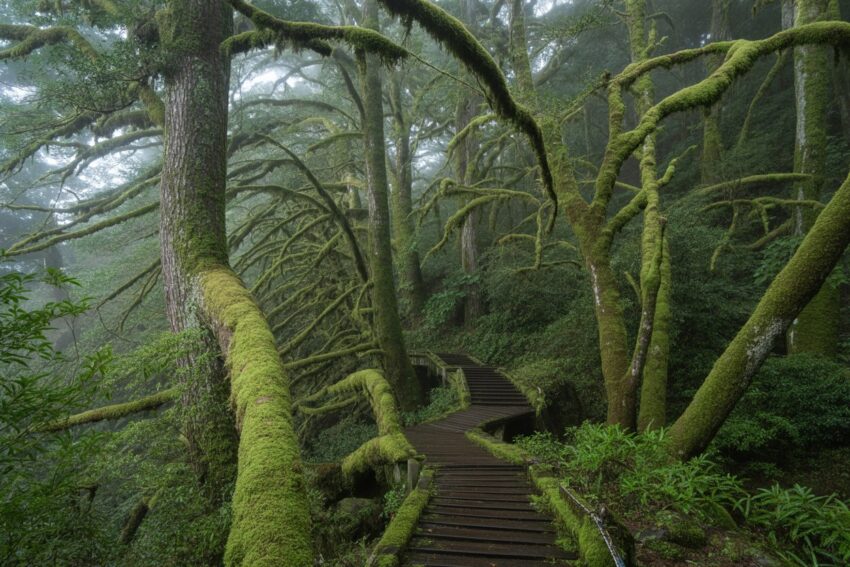Published on
November 7, 2025

On the remote shores of southern Kyūshū in Kagoshima Prefecture, Yakushima Island has emerged as a magnet for nature travel and heritage tourism. With its dense ancient cedar forests, dramatic mountain terrain, and dedicated conservation framework, the island is drawing visitors seeking immersive eco‑experiences while generating meaningful regional tourism impact.
Heritage value and ecological uniqueness
Yakushima Island holds a rare distinction as one of Japan’s earliest UNESCO World Natural Heritage Sites, inscribed in December 1993. Around 10,747 hectares — roughly one‑fifth of the island’s total area — were formally registered for their outstanding natural value.
The heritage zone spans from sea‑level vegetation up to mountain peaks nearing 1,936 metres (Mt Miyanoura) and features an uninterrupted altitudinal gradient of vegetation types — from subtropical coastal species to cold‑temperate alpine grasses. The heavily rain‑fed ecosystem (with rainfall in some mountain sectors exceeding 8,000 mm annually) supports the famed yaku‑sugi (Japanese cedar) trees, some over a thousand years old.
These ecological and scenic credentials underpin the tourism appeal: visitors do not merely hike or sight‑see, they enter a living natural heritage system.
Tourism angle: what draws travellers
Ancient forests & signature trees
The yaku‑sugi cedar forest remains a primary draw. The iconic Jōmon Sugi cedar, tucked deep within the mountain interior, adds to the mystique — though reaching it demands a full‑day trek.
Hiking trails and mountain experience
Yakushima offers trails of varying lengths and difficulties, from accessible forest walks to challenging multiple‑hour mountain treks. The mountain wilderness appeals to both nature enthusiasts and seasoned hikers.
Biodiversity & dramatic nature
With its vertical vegetation distribution and rich flora and fauna (around 1,900 plant species documented), the island caters to eco‑tourism, bird‑watching, botanical interest, and nature photography.
Brand value via UNESCO status
The UNESCO listing elevates Yakushima’s tourism profile internationally, positioning it alongside Japan’s top natural destinations.
Wellness and remote‑nature escape
Beyond trails and trees, the island offers peace, subtle luxury lodgings, forest‑bathing ambience, and branding as a place to disconnect from urban life — fitting modern tourism demands for authenticity and nature immersion.
Regional tourism and economic impact
The growth of tourism on Yakushima supports the regional economy in multiple ways:
- Extended stays and higher‑value trips: Visitors planning full‑day hikes or multi‑day stays translate into greater lodging, food, and transport spend compared with day‑trip destinations.
- Diversified local employment: From trail‑guiding, accommodation, local transport (ferry/air) to craft and nature‑interpretation services, the tourism sector provides new income streams for the island community.
- Off‑mainstream destination: While many Japanese tourists head to urban or beach resorts, Yakushima offers a less crowded, more premium ‘wilderness’ product — enabling price premiums and stronger yield per visitor.
- Seasonal resilience: Because the island’s appeal spans all seasons (lush greenery, waterfalls in warm months; moss‑covered forest and misty ambiance year‑round), it is less prone to the steep peaks/troughs of typical seasonal tourism.
Together, these factors align to enhance local livelihoods, support infrastructure investment, raise the island’s international profile, and contribute to Kagoshima Prefecture’s overall tourism offering.
Sustainability, preservation & management concerns
Any destination built on fragile natural heritage must navigate risks. Key considerations for Yakushima include:
- Visitor pressure on trails: Popular routes such as those to Jōmon Sugi may suffer erosion, congestion, or habitat disturbance; strict trail access and visitor education are essential.
- Infrastructure balance: Roads, ferries, lodging, and facilities must be developed without degrading the very ecosystems that attract visitors.
- Conservation oversight: The island is governed by a multi‑layered management plan involving national park status, wilderness designation, municipal oversight, and the UNESCO framework.
- Community integration: Tourism must bring benefit to the residents, avoiding displacement or commodification that undermines long‑term sustainability.
- Climate and ecological threats: The high rainfall, steep terrain, and complexity of ecosystems mean that sensitivity to changes (climate shifts, invasive species, overuse) is high.
By combining sustainable tourism strategy with robust preservation efforts, Yakushima can sustain the dual aims of visitor growth and heritage protection.
Future opportunities and strategic outlook
- High‑end niche tourism: Luxury eco‑lodges, guided wilderness treks, night‑forest experiences, and bespoke nature tours can attract international travellers willing to pay more for a premium experience.
- Interpretative storytelling: Enhanced visitor education via digital apps, interpretive centres (such as the Yakushima World Heritage Conservation Center), and immersive hikes will deepen engagement and yield positive word‑of‑mouth.
- Seasonally‑distributed offerings: Promoting lesser‑visited seasons and alternative trail routes helps spread visitor load and extend season length.
- Regional linkages: Connecting Yakushima with Kagoshima City, other islands, and marine nature experiences (sea turtles, coral reefs) fosters longer itineraries and increased economic impact region-wide.
- Community‑led tourism: Empowering local guides, craft makers, cuisine producers, and rural stays ensures economic benefit is localised and preserves authenticity.
If these pathways are well managed, Yakushima stands to reinforce its role as a model of nature‑based, heritage‑rich tourism destination in Japan.
Human‑centred perspective
For the traveller stepping into the mossy forest canopy on Yakushima, the experience is transformative: towering cedars whispering age‑old stories, the roar of waterfalls, clouds streaming over mountain ridges, trails winding through forest that feels timeless. These are more than scenic backdrops — they evoke a sense of place, continuity, and renewal. For the local community, these moments of visitor wonder translate into economic opportunity and reason to protect the landscape that defines their identity.







